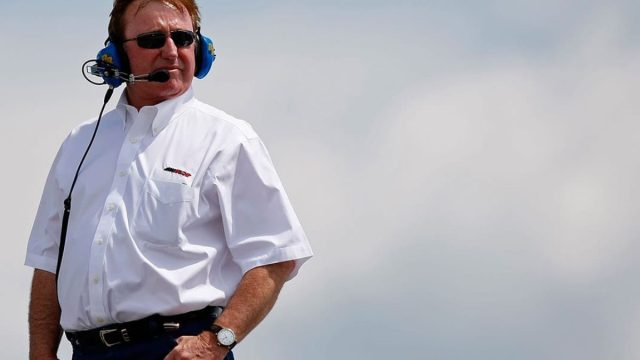Richard Childress’ Bristol Tire Warning: Following Richard Childress’ pre-race tire warning at Bristol, NASCAR was faced with pivotal decisions, prompting speculation about their response to the seasoned team owner’s alert. Childress’ attention to detail and safety highlighted the impact of tire wear on speed, handling, and race strategy, emphasizing the need for open communication between the team owners and race organizers.
Insights into Goodyear’s response and the emergence of strategic tire conservation as a key factor further emphasized the intricate balance between tire performance and track conditions. The tire wear issue’s effects on strategy, race dynamics, and the return to old-school racing at Bristol allude to a deeper exploration of the implications of NASCAR listening to valuable warnings from experienced figures.
Key Takeaways
- Richard Childress alerted NASCAR officials about potential tire wear concerns before the race.
- Greg Stucker from Goodyear addressed the tire issue during the race.
- Tire conservation became crucial for teams due to excessive wear.
- Tire wear impacted race strategies and dynamics at Bristol.
- The race emphasized old-school racing, highlighting driver skills and tire management.
Richard Childress’ Pre-Race Warning
Prior to the Food City 500 race at Bristol Motor Speedway, Richard Childress proactively alerted NASCAR officials about potential tire wear concerns that could impact the event. Childress, a veteran team owner in NASCAR, took the initiative to inform the officials of the emerging issue, demonstrating his keen attention to detail and commitment to the safety and competitiveness of the race.
Childress’ decision to raise the alarm about tire wear highlights his deep understanding of the intricacies of NASCAR racing. Tire wear is an essential factor in racing performance, affecting speed, handling, and overall race strategy. By addressing this matter with NASCAR, Childress demonstrated a preventive stance crucial in the field of professional motorsports.
The fact that Childress communicated his concerns directly to NASCAR officials shows the significance of open dialogue between the team owners and race organizers. In a sport where split-second decisions can make all the difference, effective communication and collaboration are key to ensuring a successful and safe racing environment.
Childress’ actions also raise questions about how NASCAR responds to such warnings from experienced figures in the racing community. Did NASCAR take Childress’ concerns seriously? How did they address the potential tire wear issue during the race? These are essential questions that warrant further investigation to understand the dynamics at play in ensuring a fair and competitive racing environment.

Goodyear’s Response
Goodyear’s director of racing, Greg Stucker, addressed the tire issue during an in-race news conference by highlighting the potential factors contributing to the excessive wear experienced at the Bristol race. Stucker noted that Goodyear had produced a tire similar to the one used in the previous fall’s Bristol race, which had shown notably better performance. However, Stucker pointed out that the resin applied to the concrete track surface for Sunday’s race might have played a role in the increased tire wear.
Stucker’s acknowledgment of the differences in track conditions from one race to another sheds light on the complexities of tire performance in NASCAR. The resin used on the concrete surface could have interacted with the tires in a way that Goodyear did not anticipate, leading to the accelerated wear that teams experienced during the Bristol race.
While Goodyear’s tires are designed to withstand the challenging conditions of NASCAR racing, unexpected variables like track treatments can still impact their performance. Stucker’s analysis of the potential impacts of the resin offers essential background information for comprehending the tire challenges encountered at Bristol, showing the delicate interplay between tire design and track circumstances in professional racing.
Tire Conservation Becomes Key
Amidst the challenging conditions at the Bristol race, the necessity for strategic tire conservation emerged as a pivotal factor in determining teams’ success on the track. Through the first stage of the race, it became evident that tire management would be essential for teams aiming for a strong finish. Racing aggressively at the front of the pack was causing significant tire wear, leading to handling issues and decreased performance as the race progressed. Richard Childress’ earlier warning to NASCAR about tire wear concerns now seemed prescient, emphasizing the importance of effectively managing tire usage to maintain a competitive advantage.
To illustrate the significance of tire conservation, let’s explore a comparison of tire strategies employed by top teams during the Bristol race:
| Team | Tire Strategy | Outcome |
| Team A | Aggressive tire wear |
Experienced handling issues late in race
|
| Team B | Conservative approach |
Maintained consistent performance
|
| Team C | Balanced strategy |
Optimal tire management throughout
|
| Team D | Tire preservation |
Avoided pit stops, gained positions
|
| Team E | High wear, high pace |
Early speed compromised late in race
|
These examples demonstrate the direct correlation between strategic tire conservation and on-track performance, highlighting the critical role tires played in determining the race outcome. Teams that effectively balanced speed with tire preservation were able to navigate the challenging conditions at Bristol successfully.
Impact on Strategy and Race Dynamics
The impact of tire wear on strategic decisions and race dynamics at the Food City 500 became increasingly pronounced as teams navigated the demanding conditions of the Bristol track. Teams were forced to adjust their strategies on the fly as they grappled with the challenge of excessive tire wear. Drivers, including Kyle Busch, had to carefully manage their pace to conserve tires and avoid the risk of blowouts that could derail their race.
The need for tire conservation added complexity to the race dynamics, with teams weighing the trade-off between pushing for position and preserving their tires for a longer stint. This dynamic created an intriguing spectacle for the fans, as they witnessed the drivers and teams strategizing in real-time to cope with the tire wear issue.
NASCAR might need to reassess the tire allocation for future races at Bristol to maintain a more balanced competition. Providing teams with additional tires could reduce some of the pressure on the drivers to manage their tires conservatively, potentially leading to more aggressive racing and varied strategies.
Return to Old-School Racing at Bristol
Embracing a nostalgic ethos of grit and skills, the recent race at Bristol Motor Speedway evoked the essence of old-school racing for all the fans and competitors. The revival of traditional racing at Bristol reintroduced several fundamental aspects reminiscent of NASCAR’s origins:
- Tire Management: The excessive tire wear at Bristol placed a premium on drivers’ ability to manage their tires throughout the race. This aspect added an extra layer of strategy and skills, reminiscent of racing challenges from decades past.
- Close-quarters Racing: The tight confines of Bristol Motor Speedway encouraged close-quarters racing, bumping, and aggressive maneuvers. Fans witnessed intense battles for position, mirroring the fierce competition that defined old-school racing.
- Unpredictability: With tire wear playing a significant role, the race outcomes became more unpredictable. This unpredictability added excitement and suspense, keeping fans on the edge of their seats until the checkered flag waved.
- Driver Skill and Experience: The demanding nature of Bristol’s track highlighted the importance of driver skills and experience. Drivers had to rely on their abilities to navigate the challenging track conditions, showcasing the talent and grit required in old-school racing.
News in Brief
Richard Childress’ caution regarding the tires at Bristol raised concerns that Goodyear had to tackle. The emphasis on tire preservation during the race changed strategies and dynamics, resulting in a revival of traditional racing at Bristol. This shows the significance of heeding experienced voices in the sport to guarantee a safe and competitive racing environment.

Our Reader’s Queries
Q. What does bleeding tires mean in Nascar?
A. In NASCAR, “bleeding tires” refers to the process of releasing air pressure from the tires during a pit stop. This is done to adjust the tire pressure to better suit the track conditions or to improve the handling of the car. By bleeding air from the tires, teams can fine-tune the grip level and performance of the tires to optimize the car’s performance on the track.
Q. What kind of air does Nascar use in their tires?
A. NASCAR teams opt for nitrogen instead of regular air for inflating tires because nitrogen is more stable and less prone to pressure changes with temperature fluctuations. This stability allows teams to more accurately predict and control tire pressure, which is crucial for maintaining consistent performance throughout a race. Unlike regular air, nitrogen contains fewer impurities such as water vapor, which can expand or contract with temperature changes, affecting tire pressure. Overall, using nitrogen helps NASCAR teams maintain more consistent tire pressure levels, enhancing the stability and performance of their race cars on the track.
Q. Does Nascar have rain tires?
A. The inaugural Xfinity Series race on the Daytona International Speedway road course started under damp conditions, prompting teams to consider using rain tires. However, as the weather cleared, Austin Cindric, driving the No. 22 Team Penske Ford and starting from the pole position, seized the opportunity and emerged victorious.
ALSO READ: How Kevin Harvick and DeLana Rescue Richard Childress: The Untold Story”
